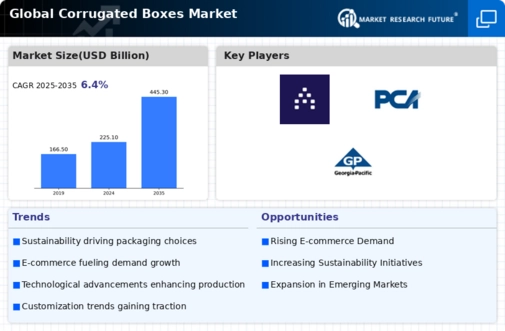-
Executive Summary
-
Scope of the Report
-
Market Definition
-
Scope of the Study
- Definition
- Research Objective
- Assumptions
- Limitations
-
Research Process
- Secondary Research
-
2.3.1
-
Primary Research
-
Market Size Estimation
-
Forecast Model
-
Market Landscape
-
Porter’s Five Forces
- Threat of New Entrants
- Bargaining Power of Buyers
- Threat of Substitutes
- Segment Rivalry
- Bargaining Power
-
Analysis
-
of Buyers
-
Value Chain/Supply Chain Analysis
-
Market Dynamics
-
4.1
-
Introduction
-
Market Drivers
-
Market Restraints
-
Market
-
Opportunities
-
Global Corrugated Boxes Market, by Type
-
Introduction
-
Rigid Boxes
- Market Estimates & Forecast, 2022-2030
-
5.2.2
-
Market Estimates & Forecast, by Region, 2022-2030
-
Self-Erecting Boxes
- Market Estimates & Forecast, 2022-2030
- Market Estimates &
-
Forecast, by Region, 2022-2030
-
Telescope Boxes
- Market Estimates
- Market Estimates & Forecast, by Region,
-
& Forecast, 2022-2030
-
Slotted Boxes
- Market Estimates & Forecast, 2022-2030
- Market Estimates & Forecast, by Region, 2022-2030
-
Others
- Market Estimates & Forecast, 2022-2030
- Market Estimates &
-
Forecast, by Region, 2022-2030
-
Global Corrugated Boxes Market, by Wall Construction
-
Introduction
-
Single-Wall
- Market Estimates & Forecast,
- Market Estimates & Forecast, by Region, 2022-2030
- Market Estimates & Forecast, 2022-2030
- Market
-
6.3
-
Double-Wall
-
Estimates & Forecast, by Region, 2022-2030
-
Triple-Wall
- Market
- Market Estimates & Forecast,
-
Estimates & Forecast, 2022-2030
-
by Region, 2022-2030
-
Global Corrugated Boxes Market, by Application
-
7.1
-
Introduction
-
Food & Beverages
- Market Estimates & Forecast,
- Market Estimates & Forecast, by Region, 2022-2030
- Market Estimates & Forecast, 2022-2030
-
7.3
-
Consumer Goods
-
7.3.2
-
Market Estimates & Forecast, by Region, 2022-2030
-
Personal Care
- Market Estimates & Forecast, 2022-2030
- Market Estimates &
-
Forecast, by Region, 2022-2030
-
Pharmaceuticals
- Market Estimates
- Market Estimates & Forecast, by Region,
-
& Forecast, 2022-2030
-
E-Commerce
- Market Estimates & Forecast, 2022-2030
-
Market Estimates & Forecast, by Region, 2022-2030
-
Others
- Market Estimates & Forecast,
-
7.7.1
-
Market Estimates & Forecast, 2022-2030
-
by Region, 2022-2030
-
Global Corrugated Boxes Market, by Region
-
Introduction
-
North America
- Market Estimates & Forecast, 2022-2030
-
8.2.2
-
Market Estimates & Forecast, by Type, 2022-2030
-
& Forecast, by Wall Construction, 2022-2030
-
Forecast, by Application, 2022-2030
-
& Forecast, 2022-2030
-
8.2.6
-
Canada
-
Estimates & Forecast, by Type, 2022-2030
-
Forecast, by Wall Construction, 2022-2030
-
by Application, 2022-2030
-
Forecast, 2022-2030
-
8.2.7.4
-
Market Estimates
-
Market Estimates &
-
US
-
Market Estimates
-
Market Estimates & Forecast, by Type,
-
Market Estimates & Forecast, by Wall Construction, 2022-2030
-
Market Estimates & Forecast, by Application, 2022-2030
-
Market Estimates & Forecast, 2022-2030
-
Market
-
Market Estimates &
-
Market Estimates & Forecast,
-
Mexico
-
Market Estimates &
-
Market Estimates & Forecast, by Type, 2022-2030
-
Market Estimates & Forecast, by Wall Construction, 2022-2030
-
Market Estimates & Forecast, by Application, 2022-2030
-
Europe
- Market Estimates & Forecast,
- Market Estimates & Forecast, by Wall Construction,
- Market Estimates & Forecast, by Application, 2022-2030
- UK
-
8.3.1
-
Market Estimates & Forecast, 2022-2030
-
by Type, 2022-2030
-
8.3.5.2
-
Market Estimates & Forecast, by Type, 2022-2030
-
& Forecast, by Wall Construction, 2022-2030
-
Forecast, by Application, 2022-2030
-
& Forecast, 2022-2030
-
8.3.7
-
France
-
Estimates & Forecast, by Type, 2022-2030
-
Forecast, by Wall Construction, 2022-2030
-
by Application, 2022-2030
-
8.3.8.3
-
Market Estimates
-
Market Estimates &
-
Germany
-
Market Estimates
-
Market Estimates & Forecast, by Type,
-
Market Estimates & Forecast, by Wall Construction, 2022-2030
-
Market Estimates & Forecast, by Application, 2022-2030
-
Market Estimates & Forecast, 2022-2030
-
Market
-
Market Estimates &
-
Market Estimates & Forecast,
-
Italy
-
Market Estimates & Forecast,
-
Market Estimates & Forecast, by Type, 2022-2030
-
Market Estimates & Forecast, by Wall Construction, 2022-2030
-
Estimates & Forecast, by Application, 2022-2030
-
& Forecast, by Type, 2022-2030
-
by Wall Construction, 2022-2030
-
Application, 2022-2030
-
8.4.3
-
Market
-
Rest of Europe
-
Market Estimates & Forecast, 2022-2030
-
Market Estimates
-
Market Estimates & Forecast,
-
Market Estimates & Forecast, by
-
Asia-Pacific
- Market Estimates & Forecast,
- Market Estimates & Forecast, by Type, 2022-2030
-
Market Estimates & Forecast, by Wall Construction, 2022-2030
-
Estimates & Forecast, by Application, 2022-2030
-
8.4.5.1
-
Market Estimates & Forecast, 2022-2030
-
by Type, 2022-2030
-
8.4.6.2
-
Market
-
China
-
Market Estimates & Forecast,
-
Market Estimates & Forecast, by Wall Construction,
-
Market Estimates & Forecast, by Application, 2022-2030
-
Japan
-
Market Estimates & Forecast, 2022-2030
-
Market Estimates & Forecast, by Type, 2022-2030
-
& Forecast, by Wall Construction, 2022-2030
-
Forecast, by Application, 2022-2030
-
& Forecast, 2022-2030
-
8.4.8
-
Rest of Asia-Pacific
-
Estimates & Forecast, by Wall Construction, 2022-2030
-
& Forecast, by Application, 2022-2030
-
8.5.1
-
Market Estimates & Forecast, 2022-2030
-
by Type, 2022-2030
-
Estimates & Forecast, by Wall Construction, 2022-2030
-
& Forecast, by Application, 2022-2030
-
& Forecast, by Type, 2022-2030
-
by Wall Construction, 2022-2030
-
Application, 2022-2030
-
Market Estimates
-
Market Estimates &
-
India
-
Market Estimates
-
Market Estimates & Forecast, by Type,
-
Market Estimates & Forecast, by Wall Construction, 2022-2030
-
Market Estimates & Forecast, by Application, 2022-2030
-
Market Estimates & Forecast, 2022-2030
-
Market Estimates & Forecast, by Type, 2022-2030
-
Market
-
Market Estimates
-
Rest of the World (RoW)
- Market Estimates & Forecast,
- Market Estimates & Forecast, by Wall Construction,
- Market Estimates & Forecast, by Application, 2022-2030
- South America
- Middle East & Africa
-
Competitive Landscape
-
Company Profile
-
Mondi Group
- Company Overview
- Products/Services Offered
- Financial Overview
- Key Developments
- Key Strategies
- SWOT Analysis
-
Smurfit Kappa Group
- Company Overview
- Products/Services Offered
- Financial Overview
- Key
- Key Strategies
- SWOT Analysis
-
Developments
-
International
- Company Overview
- Products/Services Offered
- Key Developments
- Key Strategies
-
Paper
-
10.3.3
-
Financial Overview
-
10.3.6
-
SWOT Analysis
-
Orora Packaging Australia Pty Ltd
- Company Overview
- Products/Services Offered
- Financial Overview
- Key
- Key Strategies
- SWOT Analysis
-
Developments
-
DS Smith
- Company Overview
- Products/Services Offered
- Financial
- Key Developments
- Key Strategies
- SWOT
-
Overview
-
Analysis
-
WestRock, Georgia-Pacific LLC
- Company Overview
- Products/Services Offered
- Financial Overview
- Key
- Key Strategies
- SWOT Analysis
-
Developments
-
Archis
- Company Overview
- Products/Services
- Financial Overview
- Key Developments
- SWOT Analysis
-
Packaging (India) Pvt. Ltd
-
Offered
-
10.7.5
-
Key Strategies
-
Nefab Group
- Company
- Products/Services Offered
- Financial Overview
- Key Developments
- Key Strategies
- SWOT Analysis
-
Overview
-
Europac Group
- Company Overview
- Products/Services
- Financial Overview
- Key Developments
- SWOT Analysis
-
Offered
-
10.9.5
-
Key Strategies
-
Packaging Corporation of America
- Company Overview
- Products/Services Offered
- Financial
- Key Developments
- Key Strategies
-
Overview
-
10.10.6
-
SWOT Analysis
-
List of Tables
-
TABLE1 Global Corrugated Boxes Market,
-
by Region, 2022-2030
-
TABLE2 North America: Corrugated Boxes Market, by Country,
-
TABLE3 Europe: Corrugated Boxes Market, by Country, 2022-2030
-
TABLE4 Asia-Pacific: Corrugated Boxes Market, by Country, 2022-2030
-
TABLE5
-
RoW: Corrugated Boxes Market, by Country, 2022-2030
-
TABLE6 Global Corrugated
-
Boxes Market, by Type, by Region, 2022-2030
-
TABLE7 North America: Corrugated
-
Boxes Market, by Type, by Country, 2022-2030
-
TABLE8 Europe: Corrugated Boxes
-
Market, by Type, by Country, 2022-2030
-
TABLE9 Asia-Pacific: Corrugated Boxes
-
Market by Type, by Country, 2022-2030
-
TABLE10 RoW: Corrugated Boxes Market
-
by Type, by Country, 2022-2030
-
TABLE11 Global Corrugated Boxes Market, by Wall
-
Construction, by Region, 2022-2030
-
TABLE12 North America: Corrugated Boxes
-
Market, by Wall Construction, by Country, 2022-2030
-
TABLE13 Europe: Corrugated
-
Boxes Market, by Wall Construction, by Country, 2022-2030
-
TABLE14 Asia-Pacific:
-
Corrugated Boxes Market by Wall Construction, by Country, 2022-2030
-
TABLE15
-
RoW: Corrugated Boxes Market by Wall Construction, by Country, 2022-2030
-
TABLE16
-
Global Corrugated Boxes Market, by Application, by Region, 2022-2030
-
TABLE17
-
North America: Corrugated Boxes Market, by Application, by Country, 2022-2030
-
TABLE18 Europe: Corrugated Boxes Market, by Application, by Country, 2022-2030
-
TABLE19 Asia-Pacific: Corrugated Boxes Market by Application, by Country, 2022-2030
-
TABLE20 RoW: Corrugated Boxes Market by Application, by Country, 2022-2030
-
TABLE21 Global Corrugated Boxes Market, by Region, 2022-2030
-
TABLE22 Global
-
Corrugated Boxes Market, by Type, 2022-2030
-
TABLE23 Global Corrugated Boxes
-
Market, by Wall Construction, 2022-2030
-
TABLE24 Global Corrugated Boxes Market,
-
by Application, 2022-2030
-
TABLE25 North America: Corrugated Boxes Market, by
-
Country
-
TABLE26 North America: Corrugated Boxes Market, by Type
-
TABLE27
-
North America: Corrugated Boxes Market, by Wall Construction
-
TABLE28 North
-
America: Corrugated Boxes Market, by Application
-
TABLE29 Europe: Corrugated
-
Boxes Market, by Country
-
TABLE30 Europe: Corrugated Boxes Market, by Type
-
TABLE31 Europe: Corrugated Boxes Market, by Wall Construction
-
TABLE32 Europe:
-
Corrugated Boxes Market, by Application
-
TABLE33 Asia-Pacific: Corrugated Boxes
-
Market, by Country
-
TABLE34 Asia-Pacific: Corrugated Boxes Market, by Type
-
TABLE35 Asia-Pacific: Corrugated Boxes Market, by Wall Construction
-
TABLE36
-
Asia-Pacific: Corrugated Boxes Market, by Application
-
TABLE37 RoW: Corrugated
-
Boxes Market, by Country
-
TABLE38 RoW: Corrugated Boxes Market, by Type
-
TABLE39
-
RoW: Corrugated Boxes Market, by Wall Construction
-
TABLE40 RoW: Corrugated
-
Boxes Market, by Application
-
List of Figures
-
Research Process
-
of MRFR
-
Top-Down and Bottom-Up Approach
-
Market Dynamics
-
Impact Analysis: Market Drivers
-
Impact Analysis: Market
-
Restraints
-
Porter’s Five Forces Analysis
-
Value
-
Chain Analysis
-
Global Corrugated Boxes Market Share, by Type, 2022
-
(%)
-
Global Corrugated Boxes Market, by Type, 2022-2030 (USD Million)
-
Global Corrugated Boxes Market Share, by Wall Construction, 2022 (%)
-
Global Corrugated Boxes Market, by Wall Construction, 2022-2030 (USD
-
Million)
-
Global Corrugated Boxes Market Share, by Application, 2022
-
(%)
-
Global Corrugated Boxes Market, by Application, 2022-2030 (USD
-
Million)
-
Global Corrugated Boxes Market Share (%), by Region, 2022
-
Global Corrugated Boxes Market, by Region, 2022-2030 (USD Million)
-
North America: Corrugated Boxes Market Share (%), 2022
-
FIGURE 17
-
North America: Corrugated Boxes Market by Country, 2022-2030 (USD Million)
-
FIGURE
-
Europe: Corrugated Boxes Market Share (%), 2022
-
Europe: Corrugated
-
Boxes Market, by Country, 2022-2030 (USD Million)
-
Asia-Pacific: Corrugated
-
Boxes Market Share (%), 2022
-
Asia-Pacific: Corrugated Boxes Market,
-
by Country, 2022-2030 (USD Million)
-
Rest of the World: Corrugated
-
Boxes Market Share (%), 2022
-
Rest of the World: Corrugated Boxes
-
Market by Country, 2022-2030 (USD Million)


 Source: Secondary Research, Primary Research, Market Research Future Database, and Analyst Review
Source: Secondary Research, Primary Research, Market Research Future Database, and Analyst Review






Leave a Comment